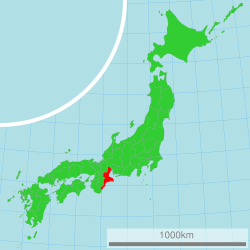Mie Prefecture facts for kids
Quick facts for kids Mie Prefecture |
|||||||||
|
|||||||||
 |
|||||||||
| Capital | Tsu | ||||||||
| Region | Kansai | ||||||||
| Island | Honshu | ||||||||
| Governor | Eikei Suzuki (since April 2011) | ||||||||
| Area (rank) | 5,777.22 km² (25th) | ||||||||
| - % water | 0.7% | ||||||||
| Population (April 1, 2010) | |||||||||
| - Population | 1,855,177 (23rd) | ||||||||
| - Density | 321 /km² | ||||||||
| Districts | 7 | ||||||||
| Municipalities | 29 | ||||||||
| ISO 3166-2 | JP-24 | ||||||||
| Website | www.pref.mie.jp/ ENGLISH/ |
||||||||
| Prefectural Symbols | |||||||||
| - Flower | Iris (Iris ensata) | ||||||||
| - Tree | Japanese cedar (Cryptomeria japonica) | ||||||||
| - Bird | Snowy plover (Charadrius alexandrinus) | ||||||||
| - Fish | Japanese spiny lobster ("Panulirus japonicus") | ||||||||
 Symbol of Mie Prefecture |
|||||||||
Mie Prefecture (三重県, Mie-ken) is a prefecture located in the Kansai region of Japan. It is on the island of Honshu, which is the largest island in Japan. The capital city of Mie Prefecture is Tsu.
Contents
What is the History of Mie Prefecture?
Mie Prefecture was formed by joining several older areas of Japan. These areas were once known as Ise Province, Shima Province, Iga Province, and part of Kii Province.
In 1871, after a big change in Japan's government, the northern part of what is now Mie became Anōtsu Prefecture. This area stretched from the Kisosansen River down to the city of Tsu. The southern part of the current Mie Prefecture became Watarai Prefecture. Then, in 1876, these two prefectures, Anōtsu and Watarai, were combined. This is how Mie Prefecture was officially created.
Different Ways People Speak in Mie
People in Mie Prefecture speak with different accents or dialects. There are four main dialects you might hear:
- Iga dialect
- Ise dialect
- Shima dialect
- Kisyuu dialect
Where is Mie Prefecture Located?
Mie Prefecture is found on the eastern side of the Kii Peninsula. This peninsula is a large piece of land that sticks out into the Pacific Ocean. Mie is surrounded by several other prefectures.
Neighboring Prefectures
The prefectures that share a border with Mie are:
- Aichi Prefecture
- Gifu Prefecture
- Shiga Prefecture
- Kyoto Prefecture
- Nara Prefecture
- Wakayama Prefecture
Major Cities in Mie Prefecture
Mie Prefecture has fourteen cities. Each city has its own unique features and attractions. The capital city, Tsu, is one of them.
Here are the cities in Mie Prefecture:
- Iga
- Inabe
- Ise
- Kameyama
- Kumano
- Kuwana
- Matsusaka
- Nabari
- Owase
- Shima
- Suzuka
- Toba
- Tsu (This is the capital city)
- Yokkaichi
Protecting Nature: National Parks
About 35% of the total land area in Mie Prefecture is protected as national parks. These parks help to preserve the beautiful natural landscapes and wildlife of the region.
Important Shrines and Temples
Mie Prefecture is home to several important Shinto shrines. These shrines are special places of worship in Japan.
The main Shinto shrines in Mie Prefecture are:
- Aekuni jinja
- Tsubaki jinja
- Izawa jinja
These are known as ichinomiya, which means they are the most important shrines in their former provinces.
Related Information
If you want to learn more about Japan's geography and history, you can check out these pages:
Images for kids
See also
 In Spanish: Prefectura de Mie para niños
In Spanish: Prefectura de Mie para niños











